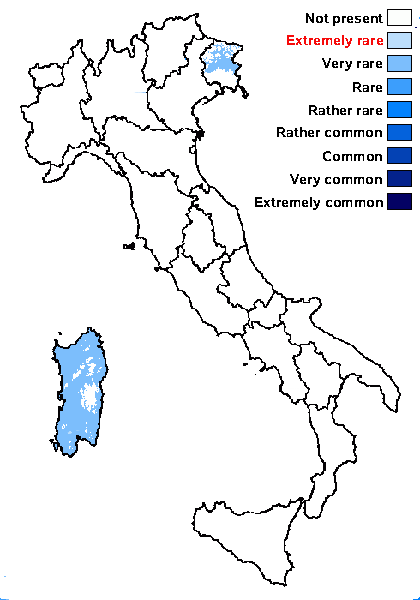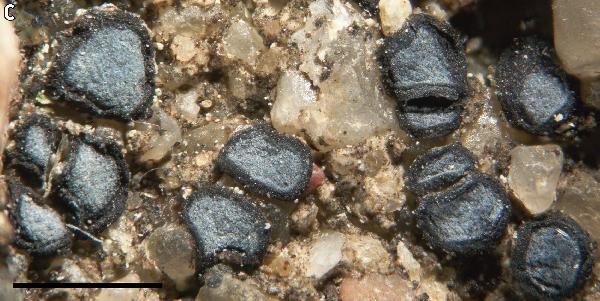Sarcogyne belarusensis K.Knudsen, Tsurykau, Kocourk. & Hodková
Herzogia, 36, 1: 64, 2023
Synonyms:
Distribution: N - Frl (Knudsen & al. 2023). C - Sar (Knudsen & al. 2023).
Description: Thallus endolithic, inapparent. Apothecia lecideine, round, dispersed, broadly attached, sometimes semi-immersed in the rock when young, 0.2-0.7(-1) mm across, 0.2-0.4 mm thick, with a black to dark brown, usually pruinose, flat to convex disc, and a slightly raised, persistent, usually smooth proper margin. Proper exciple 40-100 μm wide, with a black outer part and a colourless inner part, the hyphae with black apical cells, reacting K/I-; epithecium reddish-brown c. 15 μm high; hymenium colourless, (80-)90-120 μm high, the hymenial gel hemiamyloid, K/I+ pale blue quickly turning brownish-red or red when squashed; paraphyses 1-1.5 μm thick, coherent, simple to sparingly branched, regularly septate, the apical cells unexpanded, sometimes with a 2(-4) μm wide gel cap; subhymenium c. 10 μm high, K/I+ blue; hypothecium indistinct from medulla, colourless, c. 100 μm high, the hyphae branching, c. 1 μm thick, obscure with crystals or not, K/I-, continuous with the endolithic thallus. Asci >100-spored, cylindrical-clavate, strongly thickened at apex, the apical dome K/I-, the outer coat K/I+ blue, 10-22 x 90-100 μm. Ascospores 1-celled, hyaline, ellipsoid but looking globose in asci, (3-)3.7- 4.7(-5.5) x (1.5-)1.7-2.2(-2.5) μm. Photobiont chloroccoid, the cells mostly present inside the rock around the apotecia. Spot tests: thallus K-, C-, KC-, P-, UV-. Chemistry: thallus without lichen substances.Note: currently known from Belarus, Germany and Italy on small calcareous stones and concrete, one specimen from calcareous conglomerate sandstone, at low elevations <300 m
Growth form: Crustose endolithic
Substrata: rocks
Photobiont: green algae other than Trentepohlia
Reproductive strategy: mainly sexual
Subcontinental: restricted to areas with a dry-subcontinental climate (e.g. dry Alpine valleys, parts of Mediterranean Italy)
Pioneer species
Commonnes-rarity: (info)
Alpine belt: absent
Subalpine belt: absent
Oromediterranean belt: absent
Montane belt: absent
Submediterranean belt: very rare
Padanian area: absent
Humid submediterranean belt: very rare
Humid mediterranean belt: very rare
Dry mediterranean belt: very rare

Predictive model
Herbarium samples
Growth form: Crustose endolithic
Substrata: rocks
Photobiont: green algae other than Trentepohlia
Reproductive strategy: mainly sexual
Subcontinental: restricted to areas with a dry-subcontinental climate (e.g. dry Alpine valleys, parts of Mediterranean Italy)
Pioneer species
Commonnes-rarity: (info)
Alpine belt: absent
Subalpine belt: absent
Oromediterranean belt: absent
Montane belt: absent
Submediterranean belt: very rare
Padanian area: absent
Humid submediterranean belt: very rare
Humid mediterranean belt: very rare
Dry mediterranean belt: very rare

Predictive model
| Herbarium samples |
 Index Fungorum
Index Fungorum
 GBIF
GBIF


